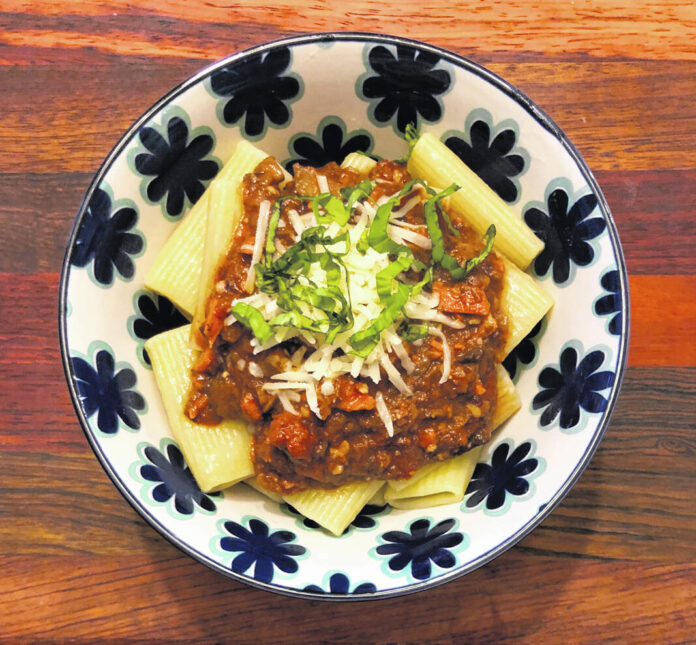Choosing to go meatless can be a challenge at any time of year. But winters can provide an extra hurdle, since overflowing baskets of garden-fresh produce are a distant memory.
Start with familiar territory. You probably have meals in your rotation that are already meatless (pasta primavera) or can easily become so. Make chili with extra beans and skip the meat. Craft a burrito bowl with roasted vegetables. Instead of a hamburger, sub a portobello mushroom or black-bean burger. Stir-fries or soups chock-full of vegetables are just as delicious as those with meat.
Go slow. It’s best not to go cold turkey, so to speak. Several experts recommend a phased approach to meet your meatless goals. Hop aboard the Meatless Monday bandwagon and choose one meal or day a week to commit to being meat-free. From there, increase the frequency at a pace that’s comfortable. Another tip: Start by eliminating red meat first, followed by pork, poultry and finally seafood.
Replace what you remove. The protein and calorie count is higher in meat than plants, so you’ll need to make sure you’re filling the nutritional gaps. Incorporate meatless forms of filling protein into your menus, such as sweet potatoes, legumes, nuts, seeds, quinoa, soy and dairy products (unless you’re adapting a vegan diet). Be sure to read labels, too; foods you may think are plant-based might not be (Caesar salad dressing) and some plant-based foods are highly processed, negating the positive health effects of going meatless.
Make a plan. Menu planning will be worth your while. Plan not only dinners, but also breakfasts, lunches and snacks to make shopping easier and keep food waste down. Eating out? No problem. Most restaurants have meatless options or dishes that can be tailored to your needs, and the number of vegetable-forward and vegan restaurants in the Twin Cities is growing.
Try new foods. A meatless diet doesn’t mean you’re destined to a life of leafy greens. While salads are great, it’s a big nutritious world out there. Take time to explore the produce section of your supermarket or co-op. Learn to make the most of what’s in season, and while we all have our go-tos, incorporating new fruits and vegetables into your menu can be fun and challenging. Which leads to …
Go recipe hunting. My family has learned to put up with my New Recipe Nights. Some of these test dishes earn a place in the regular rotation; others are quietly forgotten. But my enthusiasm never wavers. There’s a wealth of recipes out there, and the cookbook section of a bookstore is a great place to start. Think about the approach and cuisine that works for you, and there’s probably a cookbook for it. You can find vegetarian and vegan-friendly cookbooks, as well as titles dedicated to vegetables and meatless cooking in multicookers and air fryers.
Keep your doctor in the loop. As with any lifestyle change, make sure your medical team is aware of your goals. They, too, can often offer resources and support.
MUSHROOM AND WALNUT BOLOGNESE
Serves 8 to 10.
A colleague tipped me to this recipe, adapted from thekitchn.com. The original recipe called for vegan-style Parmesan or nutritional yeast, but I opted to use regular Parmesan. This version calls for a food processor, but you can easily chop the walnuts and vegetables if you don’t have one. Freeze leftover sauce for up to three months.
1 pound cremini (baby bella) mushrooms, wiped clean and quartered
1 teaspoon kosher salt, divided
1 cup (4 ounces) walnut halves
1 medium onion, cut into eighths
3 medium carrots, peeled and cut into eighths
2 medium celery stalks, quartered
3 cloves garlic
2 tbsp. olive oil
1/4 teaspoon red pepper flakes, plus more for serving
1 teaspoon kosher salt, divided
2 tablespoons tomato paste
3 teaspoons Italian seasoning
1 cup dry red wine, such as merlot or pinot noir
2 (28-ounce) cans whole tomatoes
1 1/2 tablespoons soy sauce
Freshly ground black pepper
1 pound dry pasta, such as rigatoni or tagliatelle, cooked according to package directions
Fresh basil, chopped, for serving
Parmesan cheese, for serving
Directions
Place 1/3 of the mushrooms in the bowl of a food processor fitted with the blade attachment. Pulse until coarsely chopped, about 5 to 7 quick bursts. Transfer to a medium bowl and repeat with the remaining mushrooms; set aside. Do not wash the food processor.
Place the walnuts in the food processor and pulse until they have the consistency of coarse sand, about 5 to 7 pulses. Transfer to a small bowl; set aside. Again, do not wash the food processor.
Place the onion, carrots, celery and garlic in the food processor and pulse until coarsely chopped, 8 to 10 pulses.
Heat the oil and red pepper flakes in a Dutch oven over medium-high heat until shimmering. Add the mushrooms and 1/2 teaspoon of the salt, and cook, stirring occasionally, until they release their moisture, are deeply browned, and their volume is reduced by two-thirds, about 15 minutes.
Add the chopped vegetable mixture and remaining 1/2 teaspoon salt. Cook the vegetables until softened and the onions are translucent but not browned, about 5 minutes. Stir in the tomato paste and cook until it is completely incorporated with the mushrooms and deepens in color, 30 seconds to 1 minute.
Add the bay leaf and Italian seasoning, then pour in the wine and scrape up any browned bits from the bottom of the pan. Simmer until the wine evaporates, about 2 minutes. Stir in the tomatoes and their juices (crush the tomatoes with your hands before you add them to the pot), soy sauce and ground walnuts. Reduce the heat and continue to simmer. Cook, stirring occasionally and continuing to break up the tomatoes, for 20 minutes. Add ground pepper and additional salt to taste.
Serve over cooked pasta with fresh basil, Parmesan and a sprinkle of red pepper flakes.







